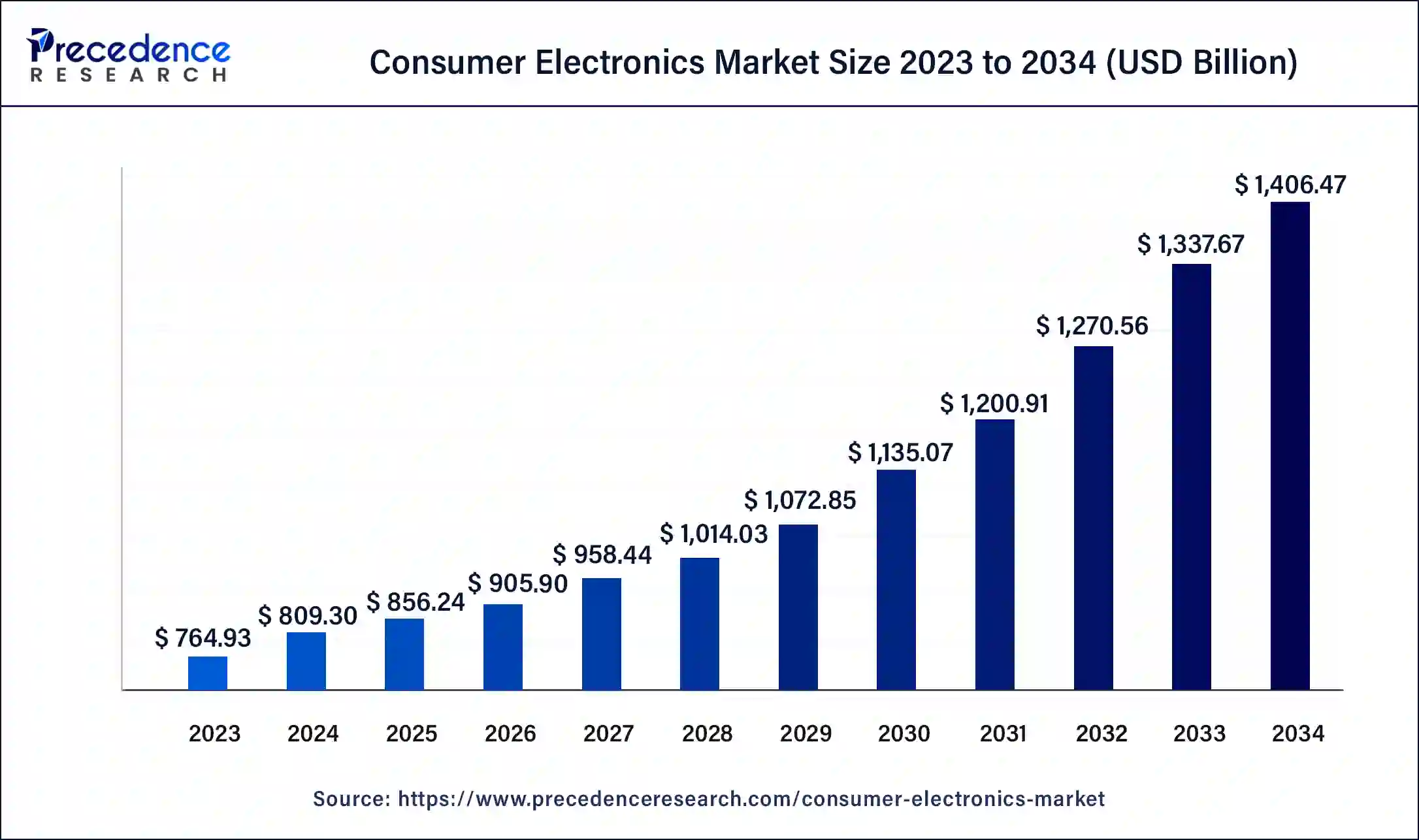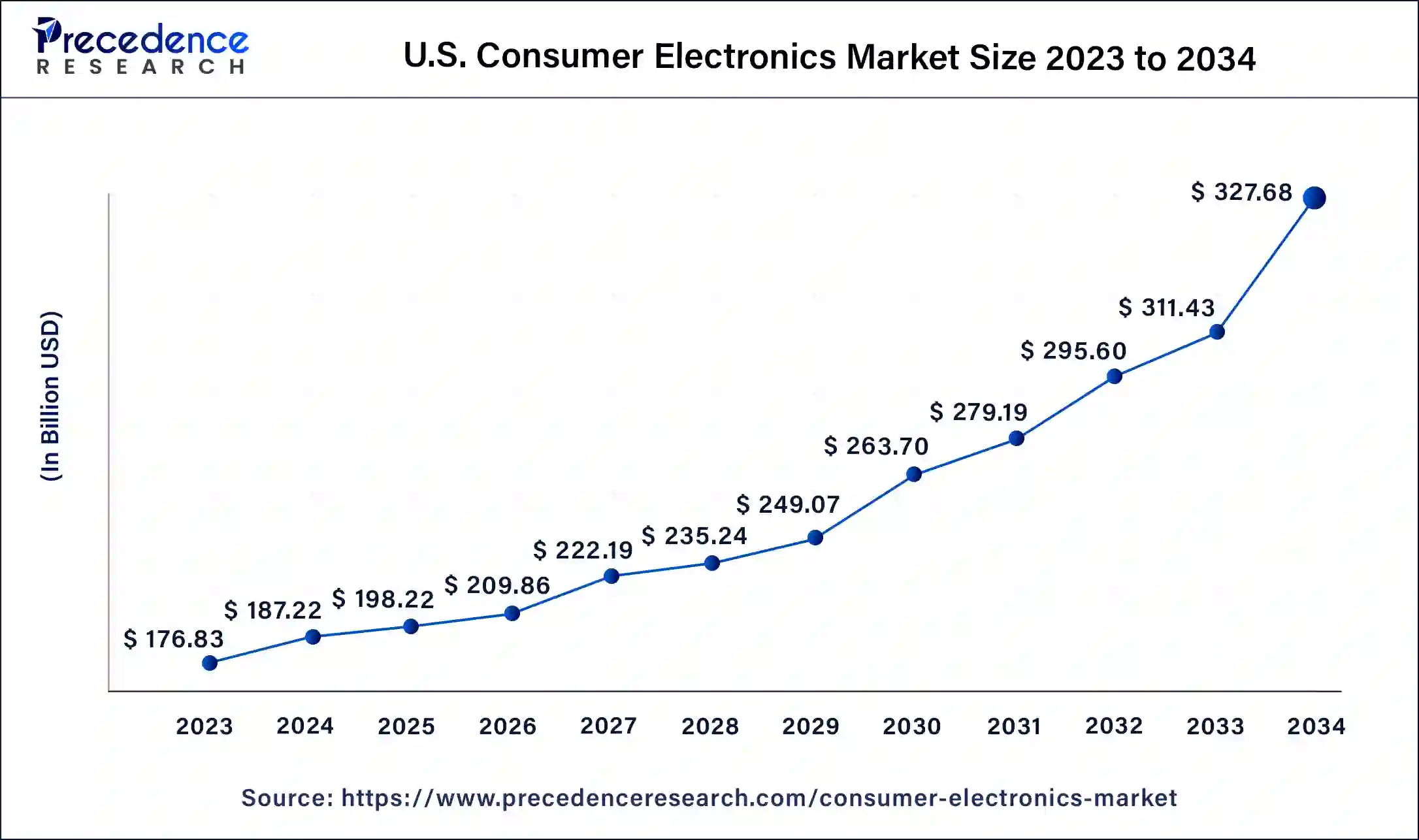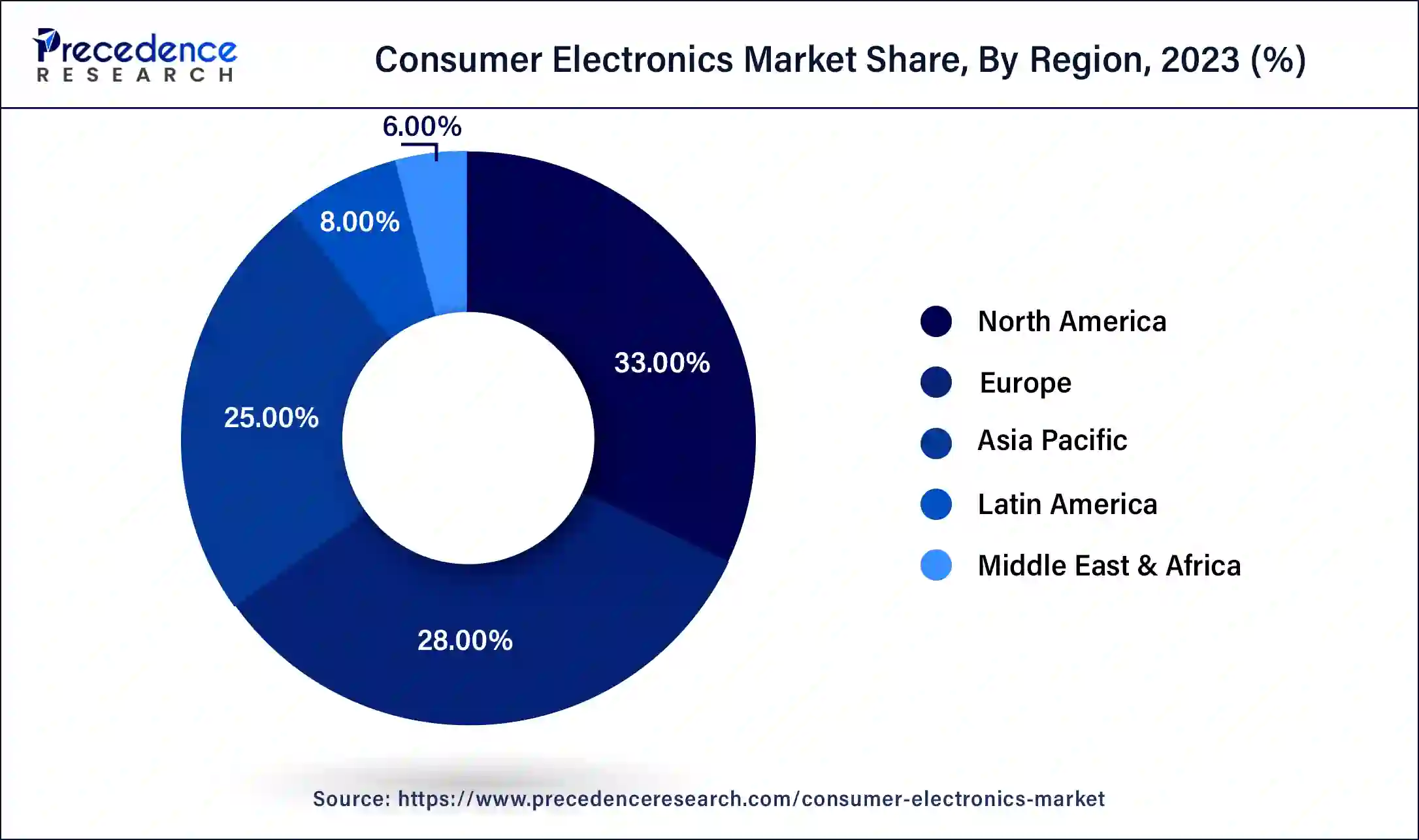December 2024
The global consumer electronics market size was USD 764.93 billion in 2023, estimated at USD 809.30 billion in 2024 and is anticipated to reach around USD 1406.47 billion by 2034, expanding at a CAGR of 5.68% from 2024 to 2034.
The global consumer electronics market size accounted for USD 809.30 billion in 2024 and is predicted to reach around USD 1406.47 billion by 2034, growing at a CAGR of 5.68% from 2024 to 2034.

The U.S. consumer electronics market size reached USD 176.83 billion in 2024 and is predicted to touch USD 327.68 billion by 2034, growing at a CAGR of 5.76% between 2024 to 2034.

North America was the dominating market in 2023. The high disposable income of the consumers, huge demand for the luxury and premium products, high standard of living, higher adoption of the latest technologies, and the presence of the top players in the region are some of the prominent factors that has driven the North America consumer electronics market.

Asia Pacific is estimated to be the fastest-growing market during the forecast period. Asia Pacific is witnessing strong economic growth owing to rapid industrialization. The favorable government policies in the countries like China and India is attracting huge FDIs in the region. The top companies are establishing their manufacturing units owing to the cheap availability of factors of production in this region. The China and India are becoming the global manufacturing hub for the electronic products. Furthermore, Taiwan and South Korea are among the top manufacturers of the consumer electronics across the globe. The rising disposable income of the consumers, presence of huge youth population, and improving standards of living are the prominent factors that are expected to drive the growth of the Asia Pacific consumer electronics market.
Consumer electronics are highly penetrated consumer products across the globe. Basically consumer electronics refer to the electronic products for non-commercial use. The increased adoption of wider varieties of consumer electronics among the household sector has significantly boosted the growth of the global consumer electronics market. Manufacturers are heavily investing towards the integration of various digital technologies in the consumer electronic products and increasingly focusing on providing high quality experiences to the consumers. The miniaturization of the electronic products is gaining rapid traction across the globe. The portability and lightweight electronic goods are gaining popularity among the consumers. Therefore, the adoption of miniature electric components is driving the growth of the global consumer electronics market across the globe. The shifting focus of the manufacturers towards the development of easy to use and convenient products is expected to drive the sales of the consumer electronics across the globe. The most popular consumer electronic products include mobile devices, laptops, computers, televisions, smartphones, refrigerators, home appliances, and wearable devices.
The surging investments by the top market players in the research and development and innovation are resulting in the new product launches with latest and innovative features. For example, Philips invested more than US$ 500 million in the first quarter of 2022 towards the research and development purpose. Moreover, the development of energy efficient electronic devices has gained significant traction among the consumers owing to the increased awareness regarding the electricity consumption and its harmful effects on the environment. Moreover, the surging investments in developing distribution networks and expansion across the globe are propelling the consumer electronics market growth.
The outbreak of the COVID-19 pandemic in 2020 had a negative impact on the consumer electronics market. The lockdown measures and travelling restrictions imposed by the government resulted in the supply chain disruptions, lack of labor, and closure of the production facilities. However, certain segments like dishwashers and laptops segments witnessed a positive growth owing to the increased expenditure on the home improvement products and rising trend of work from home. Furthermore, the e-commerce platforms played an exceptional role in the sales of the consumer electronics during the pandemic across the globe. The increasing dependence on the digital and electronic products for the personal and professional purposes is expected to have a significant impact on the market growth during the forecast period.
| Report Coverage | Details |
| Market Size by 2034 | USD 1406.47 Billion |
| Market Size in 2023 | USD 764.93 Billion |
| Market Size in 2024 | USD 809.30 Billion |
| Market Growth Rate from 2024 to 2034 | CAGR of 5.68% |
| Largest Market | North America |
| Base Year | 2023 |
| Forecast Period | 2024 to 2034 |
| Segments Covered | Product, Application, Technology, Distribution Channel, and Region |
| Regions Covered | North America, Europe, Asia-Pacific, Latin America, and Middle East & Africa |
Based on the product, the smartphones segment accounted for a revenue share of more than 60% and dominated the global consumer electronics market. The increased product acceptance, high adoption of the smartphones among the global consumers, and product innovations by the manufacturers are the major reasons behind the growth of this segment. The major three operating platforms – Android, iOS, and Windows dominates the global smartphone market. The multi-functional features and the development of miniature and cost-effective smartphones has driven the growth of this segment. The burgeoning demand for the smartphones in the developing regions is expected to further drive the growth of this segment during the forecast period. Furthermore, the emergence of 4G and 5G technologies along with the strong developments in the IT and telecommunications infrastructure is expected to have a significant impact on the market growth.
Based on the distribution channel, the global consumer electronics market was dominated by the offline segment in 2023. The presence of huge number of consumer electronic stores, small retail stores, supermarkets, and specialty electronic stores made the offline segment the most preferred distribution channel for the customers. Most of the customers increasing prefer the offline channels for buying electronic products owing to the availability of immediate gratification and the assistance of specialized sales persons during the purchase.
The online is estimated to be the fastest-growing segment during the forecast period. The rapid development of the IT and the telecommunications infrastructure, increased penetration of the online shopping platforms, significantly growing number of internet users, and increasing adoption of smartphones are the major factors that favors the growth of the online segment. The online sellers provides wider variety of products and brands, flexible payment options, easy return and exchange policies, quick home delivery, and 24/7 customer helpline services that attracts the customers to buy consumer electronic products online.
Key Company Insights
The consumer electronics market is highly fragmented with the presence of numerous top market players. The most dominant players include Samsung, LG, Philips, Apple, Bajaj, Voltas, Hitachi, and Blue Star. These market players are investing heavily in the value-added services to gain competitive advantage and gain market share. Furthermore, these market players are engaging in various developmental strategies such as product launches, partnerships, joint ventures, and mergers to exploit the prevailing market opportunities.
Segments Covered in the Report
By Product
By Distribution Channel
By Application
By Type
By Technology
By Geography
For inquiries regarding discounts, bulk purchases, or customization requests, please contact us at sales@precedenceresearch.com
No cookie-cutter, only authentic analysis – take the 1st step to become a Precedence Research client
December 2024
April 2025
January 2025
January 2025